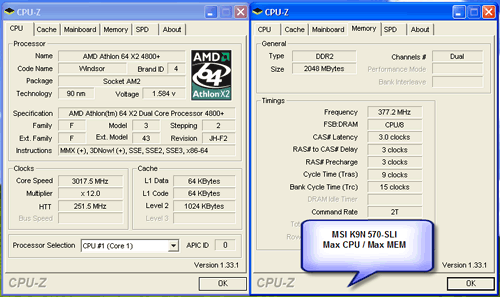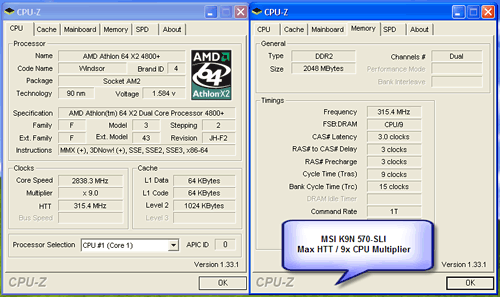NVIDIA nForce 500: Biostar and MSI Aim for the Gold
by Gary Key on June 8, 2006 4:30 AM EST- Posted in
- Motherboards
CPU/HTT Overclocking Results

This board is a good overclocker although it seemed to become unstable very quickly when pushed beyond its limits. For example, the board was extremely stable at 12x251HTT setting but this stability trailed off quickly and at 12x255HTT the board would no longer boot.
We did notice in our overclocking testing the board was very sensitive to memory settings and seemed to perform better with the memory between DDR2-667 and DDR2-800 at faster timings than increasing the memory speeds up to DDR2-1000 with relaxed timings.

The ability to hit and remain stable at 9x315HTT would normally be a joyous event but after the results of our Biostar board this result seems normal now. The ability of a board to exceed 300HTT and maintain excellent stability is now expected for a performance oriented board and MSI delivers in this case.
Memory Stress Testing
Memory stress tests look at the ability of the MSI K9N-SLI Platinum to operate at the officially supported memory frequencies of 800MHz DDR2 at the best performing memory timings the Corsair Twin2X2048-8500C5 revision will support.
The MSI board was very stable with two (1GB) DDR2 modules in Dual-Channel mode at the settings of 3-3-3-8 2T at 2.1V. The board would set 5-5-5-15 2T if the memory selection was left on auto. We did not notice any issues throughout our testing with our settings provided the voltage was set to 2.1V. Unlike the Biostar board we were unable to run the board at DDR2-667 with 1T timings in a stable fashion.
With four (1GB) Corsair modules in all four available memory slots, the MSI board was completely stable in Dual-Channel operation at the settings of 3-4-4-9 2T with the voltage set at 2.1V. Driving 4 DIMMs is much more stressful on the memory subsystem than the more common 2 DIMM configuration. These are very good results and the board performed admirably throughout our memory testing regimen that included eight to twelve hour runs of MemTest86, Prime95, and our benchmarks suites along with numerous iterations of SuperPI set at 32m.
| MSI K9N SLI Platinum | |
| Processor: | AMD Athlon 64 X2 - 4800+ (AM2) |
| Chipset: | nForce 570SLI |
| CPU Voltage: | 1.600V (1.300V default) |
| Memory Settings: | 3-3-3-9 2T 12x Multiplier 3-3-3-9 1T 9x Multiplier |
| DDR2 Results: | 12 x 251HTT = DDR2 754 9 x 315HTT = DDR2 631 |
| HT Multiplier: | 5x below 300HTT, 4x above 300HTT |
| Memory Voltage: | 2.3V |
| Chipset Voltage: | Auto |
| HT Voltage: | Auto |
| Cooling: | Zalman CNPS9500 AM2 |
| Power Supply: | OCZ GamexStream 700W |
| Maximum CPU OverClock: | 251HTT x 12 (3017MHz) +25% |
| Maximum FSB OverClock: | 315HTT x 9 (2838MHz) +57% |

This board is a good overclocker although it seemed to become unstable very quickly when pushed beyond its limits. For example, the board was extremely stable at 12x251HTT setting but this stability trailed off quickly and at 12x255HTT the board would no longer boot.
We did notice in our overclocking testing the board was very sensitive to memory settings and seemed to perform better with the memory between DDR2-667 and DDR2-800 at faster timings than increasing the memory speeds up to DDR2-1000 with relaxed timings.

The ability to hit and remain stable at 9x315HTT would normally be a joyous event but after the results of our Biostar board this result seems normal now. The ability of a board to exceed 300HTT and maintain excellent stability is now expected for a performance oriented board and MSI delivers in this case.
Memory Stress Testing
Memory stress tests look at the ability of the MSI K9N-SLI Platinum to operate at the officially supported memory frequencies of 800MHz DDR2 at the best performing memory timings the Corsair Twin2X2048-8500C5 revision will support.
| MSI K9N-SLI Platinum Stable DDR2-800 Timings - 2 DIMMs (2/4 slots populated - 1 Dual-Channel Bank) |
|
| Clock Speed: | 200MHz |
| Timing Mode: | 800MHz - Default |
| CAS Latency: | 3 |
| RAS to CAS Delay: | 3 |
| RAS Precharge: | 3 |
| RAS Cycle Time: | 8 |
| Command Rate: | 2T |
| Voltage: | 2.1V |
The MSI board was very stable with two (1GB) DDR2 modules in Dual-Channel mode at the settings of 3-3-3-8 2T at 2.1V. The board would set 5-5-5-15 2T if the memory selection was left on auto. We did not notice any issues throughout our testing with our settings provided the voltage was set to 2.1V. Unlike the Biostar board we were unable to run the board at DDR2-667 with 1T timings in a stable fashion.
| MSI K9N-SLI Platinum Stable DDR2-800 Timings - 4 DIMMs (4/4 slots populated - 2 Dual-Channel Banks) |
|
| Clock Speed: | 200MHz |
| Timing Mode: | 800MHz - Default |
| CAS Latency: | 3 |
| RAS to CAS Delay: | 4 |
| RAS Precharge: | 4 |
| RAS Cycle Time: | 9 |
| Command Rate: | 2T |
| Voltage: | 2.1V |
With four (1GB) Corsair modules in all four available memory slots, the MSI board was completely stable in Dual-Channel operation at the settings of 3-4-4-9 2T with the voltage set at 2.1V. Driving 4 DIMMs is much more stressful on the memory subsystem than the more common 2 DIMM configuration. These are very good results and the board performed admirably throughout our memory testing regimen that included eight to twelve hour runs of MemTest86, Prime95, and our benchmarks suites along with numerous iterations of SuperPI set at 32m.










17 Comments
View All Comments
Puddleglum - Thursday, June 8, 2006 - link
First comes AMD, then comes Intel. You must wait. Are you opposed to the 965/975x?Conroe comes out in about a month, so I'm sure you'll be seeing massive amounts of reviews in the coming weeks/days.
Myrandex - Thursday, June 8, 2006 - link
I don't know if it is just me, but it looks like in the graphical layout of the 570 that it says 16x connection to the first video card than an 8x connection to the second. I think it should have 16x / SLI (8x) or something on it.Jason
Myrandex - Thursday, June 8, 2006 - link
Also the following needs changed:The Realtek ALC-883 codec offers competitive CPU utilization rates when compared to the Realtek ALC-882 on the Asus board.
I think the Asus needs to be changed to Biostar.
JarredWalton - Thursday, June 8, 2006 - link
Asus changed to Biostar. As for the nF570 graphic, the X16 is because if you use a single GPU, you can get all 16 lanes, but if you use two GPUs, both will get 8 lanes. Yeah, it could be done better, but that image is direct from NVIDIA.Regards,
Jarred Walton
Editor
AnandTech.com
shortylickens - Thursday, June 8, 2006 - link
They jusy had to add two more digits, didnt they?Couldnt call it the Nforce 55, 57 and 59. Are they trying to compete on names again? Must need that extra digit I guess.
Before long we'll have Radeon XXXYYYZZZ9700 Thousand Million Pro Uber Leet Haxor and then we'll see GeForce 999 FXZ 88000 Ultra Grand Prix GT XML.
Then someone will get the idea to simplify the naming system and the whole mess starts over.
Visual - Friday, June 9, 2006 - link
Does the XML model also offer XSLT hardware acceleration? That'd rock, explorer is so slow on it...But I think I'll hold up for now till I can get the Turbo-Diesel Injection models.
Schizzlefuzz - Thursday, June 8, 2006 - link
I've only used Biostar for budget builds before, using DFI and Asus for performance builds, but the TForce 590 SLI Deluxe might be added when I start building AM2 systems for customers.